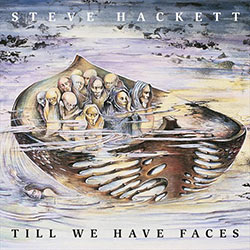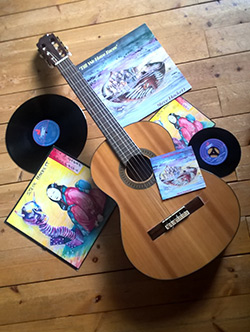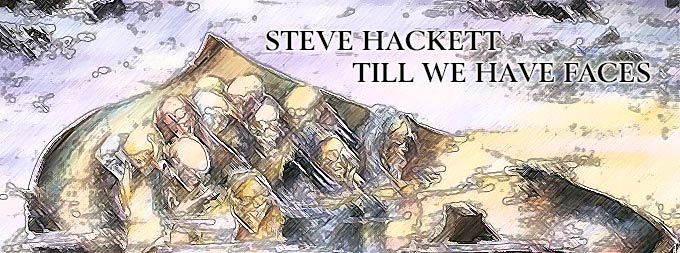- Article
- Read in 10 minutes
Steve Hackett – Till We Have Faces – album review
Steve Hackett’s 1984 solo album Till We Have Faces is not ranked among his best, also not a fan’s favorite. Reason enough for Thomas Jesse to take a closer look at this album.
Steve Hackett found a new label in „Lamborghini“ after he had left Charisma Records when he felt his artistic freedom limited by the label demanding higher sales figures for his albums. Lamborghini was not a major label, but a financially sound independent. They gave Steve the opportunity to release two albums in quick succession that different from his fans’ expectations and his own output so far. An acoustic album called Bay Of Kings came out in November 1983 and was followed by the world music-ish album Till We Have Faces… While Bay Of Kings had many elements of his previous output, albeit in an unplugged fashion, the other album proved more difficult. Till We Have Faces is frequently described as Hackett’s weakest album, worse even than Cured.
Hackett borrowed the title from a C.S. Lewis novella [*1]. If that name sounds familiar, it does because Steve paid homage to the author with the song Narnia on Please Don’t Touch. Lewis’ story is a retelling of the ancient Greek myth of Amor and Psyche [*2] as seen from the perspective of Psyche’s sister Orual. The cover artwork by Kim Poor resembles images of dead soul’s being ferried across the Styx to Hades, the realm of the dead, though it was, in fact, based on the Genesis song Silent Sorrow In Empty Boats [*3]. Listeners who expect a progressive rock album will be surprised.
With his then wife Kim Poor, Hackett spent a lot of time in her native country of Brazil [*4] learning about its history and culture. He was intrigued by the rhythm of their music and decided to record songs with Brazilian percussion. Bringing Brazilian percussionists to England proved too expensive, so Hackett went to Brazil in 1983 to produce parts of the album. He encountered a storm of problems: It took him weeks to get all the equipment he needed and to find a studio (they finally recorded at Som Livre in Rio); the Brazilian musicians did not really get going before midnight and would not stick to the song structures given. There were a number of exhausting night sessions. In this time Steve’s keyboarder Nick Magnus was a pillar of strength. The second half of the album was recorded in London. Producer John Acock mixed the album, too. A long list of Brazilian musicians worked on the album as well as Ian Mosley on drums. He worked on the London sessions and would find his home in Marillion.
Releases:
LP Lamborghini – LMGLP 4000 (1984)
CD Lamborghini Records ?- CDLMG 4000 (1984)
CD Start Records ?- SCD 11 (1987)
CD Herald ?- HER 010-2 (1994, US) 2 bonus tracks, different play order
CD Camino Records ?- CAMCD09 (2002) 2 bonus tracks / CD-ROM section with additional MP3 tracks
CD Inside Out Music ?- IOMCD367 (2013) 2 bonus tracks and CD-ROM Section with additional MP3
Part of the Broken Skies Outspread Wings box set (2018)
Single releases:
A Doll That Made In Japan 7′ (backed with: Doll instrumental) and 12′ (backed with: Just The Bones)
It should me mentioned that the original releases on vinyl and CD have the tracks in a different order than the later CD releases from 1994 onwards:
Original release:
Side One
1. Duel (4:50)
2. Matilda Smith-Williams Home For The Aged (8:04)
3. Let Me Count The Ways (6:06)
4. A Doll That’s Made In Japan (3:57)
Side Two
1. Myopia (2:56)
2. What’s My Name (7:05)
3. The Rio Connection (3:24)
4a. Taking The Easy Way Out (3:49)
4b. When You Wish Upon A Star (0:51)
Total time: 41:02
CD releases from 1994 onwards
1. What’s My Name (7:04)
2. The Rio Connection (3:19)
3. Matilda Smith-Williams Home For The Aged ( 8:04)
4. Let Me Count The Ways (6:05)
5. A Doll That’s Made In Japan (3:56)
6. Duel (4:48)
7. Myopia (2:54)
8. Taking The Easy Way Out (3:48)
9. The Gulf (6:30) *
10. Stadiums Of The Damned (4:37) *
11. When You Wish Upon A Star (0:48)
* Bonus tracks
Total Time: 52:00
Apparently the idea was to have more drama and more coherence for the album. Interestingly, Taking The Easy Way Out and When You Wish Upon A Star were a unit in the original release but were separated by two bonus tracks on re-released.
The songs (in the new order)

What’s My Name
This song was inspired by Shen Fu’s Six Records Of A Floating Life [*5]. Steve wanted to fuse the music of classical China with the style of native Americans. The song begins with gentle percussion line that moves ever more to the foreground. The listener is drawn, as if hypnotized, into the soundscape of the Amazon river until Steve begins to sing the lines “Stone mirror mountain rise from a low stream / The scent of flowers like an ocean of wheels…” in a painfully high voice. What a poetic image! The percussive music is supported by strong chords on the keyboard, bits of guitar and bass help fill up the wall of sound until Steve screams out the song title like an exotic animal. But there is no release, the slow percussion that has captured the listener remains. A koto [*6] adds tender, feminine touches to the image. A treacherous quiet. After all, the masculine and the feminine side, yin and yang, have to unite, to overcome the duality to answer the question of my name. This happens in the last ninety seconds of the song in full Hackett bombast. The magic ends suddenly after 7 minutes. What’s My Name is definitely a highlight on the album and a great opening song. Moving it to the front in the re-issues was a good idea. In its original position (track 2 on side B) it was easily overlooked.
The Rio Connection
The first instrumental on the album was recorded spontaneously and live in the studio. A drum duel ist the foundation. Don’t we know it from somewhere? The short instrumental begins with a bass line combined with the speaking clock; the other instruments chime in. It is an easy jam with sprinklings of jazz and blues. Steve does not only play his “singing guitar” but also the mouth organ. There is some flute. It is a bit like Brand X or Weather Report. Unfortunately, the fade-out begins too early. Must have been a bit late in the studio…
Matilda Smith Home For The Aged
“When a samba rhythm meet’s an Englishman’s lyric based on a Caribbean old folk’s home it sounds like this.” [*7] Right. Now, the song begins with a well-known tune and classic progressive rock. Hackett copies Hackett: This is Hackett To Pieces [*8] from Highly Strungwith vocals! The image of a residence for rock legends who are happy about a bottle of gin that has been smuggled in morphs into the carnival in Rio after the first third of the track: Samba, played by what seems like 1,000 percussionists. Hackett puts a delightful guitar solo on top of it, and the keyboards lift the samba into the air. What has all this to do with a “home for the aged”? Perhaps it is an ironic wink by the artist who had an idea how much this Latin rock number would scare the Genesis proggies who want him to stick to the old stuff?
Let Me Count The Ways (For Uncle Charlie)
The official blues track on the album. Steve plays a wonderfully hovering guitar that is supported by somber drums, bass and keyboards. Oh yes, he has moved a long distance from progressive rock, but that is not reason to get the blues. This could have been a real hit with a “real” blues singer, but it is a cool number anyway, isn’t it? Oh, this guitar … hello B.B. King? Hello Gary Moore?
A Doll That’s Made In Japan
This single release shows us a pop Steve Hackett who wants to bring together Asia and South America (as in What’s My Name). The song was recorded after the Brazilian sessions in the UK. A koto kicks off the song, there is percussion before the vocals come in. They are accompanied by guitar gimmicks and a traditional pop scheme of verse/chorus. A classic Hackett solo begins at 2:30 and is accompanied by Kim Poor’s spoken vocals in Japanese. The 12” version has an interesting two-minute instrumental at that point – which makes it a Hackett favorite for me. The lyrics contain a series of images that a may go through the head of a Western European person when they visit Japan. They paint the image of a secret, old Japan that lies beyond the much copied “American way of life”.
Duel
Steven Spielberg’s 1971 film [*9] is the godfather for this “Straight shuffle” (Hackett on Hackett). The sound of a starting lorry engine in the beginning is played by Nick Magnus. The rhythm of the song and Steve’s monotonous guitar convey the image of a drive on a US highway compared with a fear of being chased. Steve sings in a deeper voice, so his voice sounds less forced. The song has no Brazilian percussion, which is perhaps the reason why it is not the opening song anymore on the re-releases. It resembles Walking Through Walls from Highly Strung.
Myopia
Steve Hackett goes rock/AOR? The instrumental part is played at live show encores to this day. Vocals and songwriting are well below Steve’s average. Funnily, the song quotes one of J.S.Bach’s Brandenburg Concerts at 1:50. It is a song about myopia (duh!) that should not be taken too seriously. Unfortunately, Steve’s vocals are far too shrill.
Taking The Easy Way Out
A melancholy nightsong, very laid back, with gentle keyboards and a lovely melody on the acoustic guitar that is, unfortunately, in danger of drowning in the sea of sounds. Steve’s soft vocals fit very well into the music. This song was placed near the original end of the album with When You Wish Upon A Star.
The Gulf
A bonus track from the sessions for the never-released successor album, Feedback. The drum tracks were taken from the Till We Have Faces sessions, though. A fine melody on the acoustic guitar leads into a song with an oriental touch. A djembe, the only percussion element in the beginning, enhances this impression. After 1:50 a “wild” electric guitar puts an end to the slow music. Steve raises his voice and a smashing, basslike keyboard chord drives the song forward to a short interruption by oboe and acoustic guitar (around 3:50). Then Steve continues the conflict about different interpretations of God’s words as exemplified by the situation around the Persian Gulf in classic-progressive bombastic music. The ’94 mix of this track looks way ahead to Steve Hackett’s musical future, e.g. on The Night Siren. Compare this to the version on Feedback 86.

Stadium Of The Damned
Another bonus track from the Feedback archives. The lyrics are based on Dostoevsky’s novel Crime And Punishment. Gloomy strings evolve into an almost happy vocal melody, like a glimpse into the Russian soul. After two-and-a-half minutes there is an impression of carnival-like song acrobatics. No, no Dead Can Dance track, just too many gimmicks with classical bits that may deter the casual listener but will make the “Hacketteers” smile.
When You Wish Upon A Star
A brief outro on lightfooted keyboards. The high fanfare resembles the quiet part of Genesis’s Unquiet Slumber For The Sleepers. It ends with triangle sounds, and the curtain falls. Steve’s cover version of the Pinocchio song from the Disney movie by Ned Washington and Leigh Harline *10.
Yes, the listener will be surprised by this Steve Hackett album. As on Curedand Highly Strung the artist leaves his progressive roots behind – perhaps in order to redefine them? In the best sense of the word “progressive” he respects these roots and fuses them with elements from other musical styles to create something new. We hear samba sounds, blues and jazz, classical music and pop. A plethora of ideas that shows what Hackett thinks about music: Embark for new musical shores and bring them together with your familiar music.
Production conditions and technical limitations of the 1980s makes the whole album sound a bit heterogenous. For example, it sounds as if the Brazilian percussionists play next to instead of with the band. Some musical changes in a song sound as if tapes had been stuck together carelessly, which is a criticism on the production and mix. Hackett’s voice had not matured enough, and when he forces it to go high the effect can tire the listener.
Steve says he had a lot of fun recording in Brazil. Apparently his Brazilian musicians felt the same because they did not want to get paid *11. If you drop the blinkers and move across musical borders you are likely to enjoy the album. We should, perhaps, take it as a first and – in the best sense of the word – naïve foray into the area of world music. Who else can say they have attempted to bring world music together with prog rock in the style of Genesis?
by Thomas Jesse
English by Martin Klinkhardt
Notes
(*1) see https://en.wikipedia.org/wiki/Till_We_Have_Faces
(*2) see https://de.wikipedia.org/wiki/Amor_und_Psyche
(*3) compare Genesis Lyrics Illustrated by Kim Poor Paperback, London 10 Mai 1979, S. 88
(*4) see https://kimpoor.com/
(*5) see https://en.wikipedia.org/wiki/Six_Records_of_a_Floating_Life
(*6) see https://de.wikipedia.org/wiki/Koto
(*7) see liner notes of the re-release
(*8) compare https://www.youtube.com/watch?v=C7bm65xBxUE
(*9) see https://de.wikipedia.org/wiki/Duell_(Film)
(*10) see https://www.youtube.com/watch?v=pguMUFyJ3_U (Keith Jarrett-Interpretation)
(11*) see liner notes of the re-release

